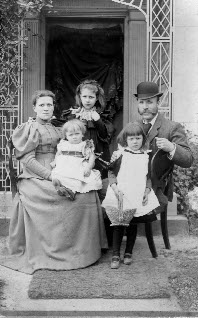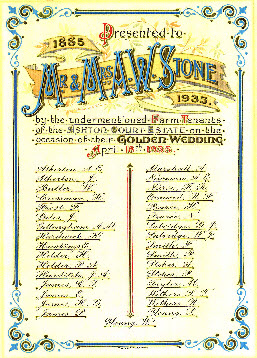


ALFRED W STONE was born in 1856 at Fir Tree Cottage, now The Well House, in Long Ashton, Bristol. He, his father and his children are buried at Long Ashton Church. His father died not long after he was born and we are told this is from shock having seen his brother Alfred's uncle fall into the molten metal at the Ashton ironworks.
Alfred left Bristol to study architecture under the guidance of an uncle and living in Bromley, Kent. He married whilst living at Bromley in April 1885 where his first child was born in May 1886. After qualifying he was bitterly disappointed at his failure with one or two applications for posts and felt that the appointments were given to those who had the right friends and connections. Against the advice of his uncle who considered that he would make a good career in London he returned to Long Ashton in 1894 to take up the appointment of architect and clerk of the works to the Ashton Court Estate which he held for 52 years until his death at 90 in 1946 just after his Diamond Wedding Anniversary.
Although he did not make a name for himself as an architect, nevertheless he was very happy indeed in his job and was very well known over a wide area when the Ashton Court Estate included many properties in the surrounding district. He was held in high esteem in Long Ashton and he was very interested in local affairs and local history. He supervised work at Long Ashton church including extensive roof repairs.
Alfred Stone of course knew Sir Greville and Lady Smyth and their daughter who in turn became Lady Smyth and following whose death the estate was broken up and the Court and park sold to the city. Although Alfred saw parts of the estate sold off to meet death duties he did not see the final break up of the estate as Lady Smyth outlived him. Alfred Stone’s office and the estate workshops etc. were where the College of Art is now situated in Bower Ashton. It was Alfred who designed and supervised the building of the original Hunting Lodge for Sir Greville Smyth which later became the Redwood Lodge. He also designed and supervised the building of the Long Ashton Cider Institute. There are doubtless many other buildings for which he was responsible during his 52 years as architect and Clerk of Works to the estate. Alfred Stone’s daughter, Kathleen Gilpin, died at age 105 in 1991. She could remember much about the Court and Estate when it was still flourishing. Her grandson Tony Davis can well remember going with Kathleen to the park where the American soldiers were stationed during the war and also meeting Lady Smyth and seeing many parts of the Court while it was still occupied. Lady Smyth insisted her name was pronounced like Smith not Smythe.
Alfred’s son, Herbert John, was awarded an MC in World War I and later became general manager of BICC. He died in 1960.


Alfred & Hannah Stone with their children
About 1895/6
About 1895/6
THE STONE FAMILY